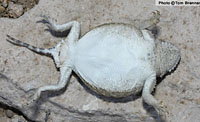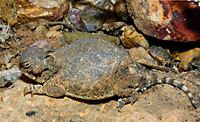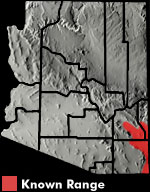Online Field Guide to The Reptiles and Amphibians of Arizona


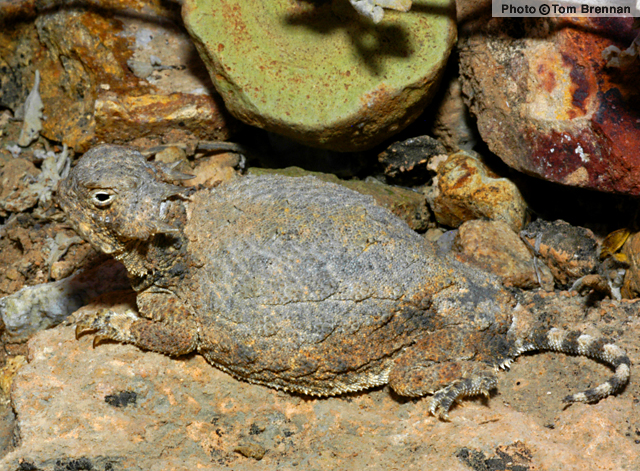
Cochise County, AZ
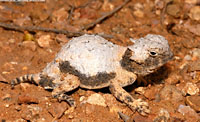 Juvenile. Cochise Co., AZ |
| ROUND-TAILED HORNED LIZARD Phrynosoma (Doliosaurus) modestum |
|
|
DESCRIPTION: A small (up to 70 mm or 2.75″ from snout to vent), exceptionally flat and wide lizard with four widely separated, short, spike-like scales projecting from the back of the head. There are a few sporadic, pointed, projecting scales on the back. The tail is thin (for a horned lizard) and round in cross-section. This lizard’s lack of a distinct fringe of enlarged, pointed scales on the lower edge of the body distinguishes it from all other Arizona horned lizards. Base coloration can be gray, pinkish-gray, tan, blue-gray, or yellow brown and can change to more closely match the soil and to aid thermoregulation. There are dark bands on the tail and dark, soft-edged, shadow-like blotches on the neck and lower sides of the body. The underside is plain white or yellow. DISTRIBUTION: This lizard is found in extreme southeastern Arizona along the border with New Mexico. In our state it occurs at elevations ranging from about 3,000′ to about 6,000’. HABITAT: Valleys, bajadas, and low foothills within Chihuahuan Desertscrub and Semidesert Grassland communities are home to this lizard. It is usually encountered in relatively open, sunlit areas with gravelly or rocky soil. BEHAVIOR: This primarily diurnal ground-dweller is most active in the mid-morning and on overcast days. It is also occasionally active at night. It hibernates during the cold months of winter and late fall. When threatened it often hunches its back, lowers its head, and remains motionless. This posture, coupled with the shadow-like markings on its lower sides, make the lizard resemble a small rock. When captured it may inflate itself by gulping air and poke with the horns. DIET: The Round-tailed Horned Lizard feeds primarily on ants but it also takes termites, beetles, butterfly and moth larvae, and other insects. REPRODUCTION: One or two clutches of eggs are laid from May through July. Clutch size ranges from 6 to 19 eggs. Hatchlings begin to emerge in July. By Thomas C. Brennan Brennan, T. C., and A. T. Holycross. 2006. A Field Guide to Amphibians and Reptiles in Arizona. Arizona Game and Fish Department. Phoenix, AZ Degenhardt, W. G., Painter, C. W., and Price, A. H.. 1996. Amphibians and Reptiles of New Mexico. University of New Mexico Press. Albuquerque. Stebbins, R.C. 2003. A Field Guide to Western Reptiles and Amphibians, Third Edition. Houghton Mifflin Company, Boston, MA. |
|
Visit Partners in Amphibian and Reptile Conservation:


HOME
Copyright © 2023, Arizona Game and Fish Department. All rights reserved.
If you make use of the textual contents of this site in reports, publications, etc. please cite and credit the author(s) and photographer(s). All photos on this website are copyrighted. However, those found in the species account section may be used for any noncommercial scientific, educational, or conservation purposes provided that photographs are not altered and continue to bear the copyright symbol and name of the photographer. Please contact the photographer regarding commercial use of copyrighted photographs.










